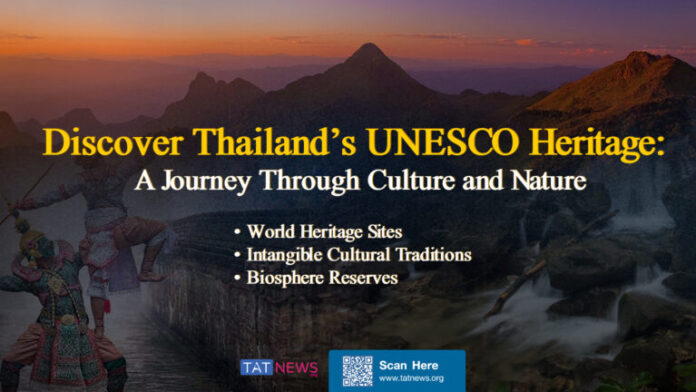Thailand features eight UNESCO World Heritage Sites, showcasing its rich cultural history and biodiversity through notable sites like Sukhothai, Ayutthaya, and diverse Biosphere Reserves, along with vibrant intangible cultural heritage.
Key Points
-
Cultural and Natural Heritage: Thailand boasts eight UNESCO World Heritage Sites, including Sukhothai and Ayutthaya, showcasing its historical architecture and urban heritage. The Thungyai-Huai Kha Khaeng Wildlife Sanctuaries and other reserves highlight the country’s rich biodiversity and natural beauty.
-
Intangible Cultural Heritage: Thailand’s vibrant traditions, such as the Khon dance, Nuad Thai massage, and Songkran festival, reflect its cultural identity and artistic expression, emphasizing the preservation of diverse regional practices.
- Biosphere Reserves: UNESCO-designated Biosphere Reserves like Sakaerat and Doi Chiang Dao focus on sustainability and conservation, showcasing Thailand’s commitment to environmental research and the preservation of unique ecosystems.
Thailand is a country rich in cultural and natural heritage, recognized by the United Nations Educational, Scientific and Cultural Organization (UNESCO) for its diverse array of sites that include eight World Heritage Sites, elements of Intangible Cultural Heritage, and designated Biosphere Reserves. These designations celebrate the nation’s historical significance, its ecological richness, and its commitment to preserving traditional arts, creating a multifaceted tourist experience.
Among the notable UNESCO World Heritage Sites are Sukhothai and Ayutthaya. Sukhothai, recognized as the birthplace of Thai civilization, offers well-preserved ruins that highlight 13th-century Siamese art and architectural ingenuity. In contrast, Ayutthaya once served as the glorious capital of the Kingdom of Siam, featuring an impressive array of grand temples and palatial remnants that evoke the grandeur of its past. For those drawn to nature, the Thungyai-Huai Kha Khaeng Wildlife Sanctuaries stand out with their rich biodiversity and unique ecosystems, providing refuge to rare wildlife. The prehistoric Ban Chiang Archaeological Site showcases Southeast Asia’s ancient heritage, while the Dong Phayayen-Khao Yai Forest Complex is lauded for its ecological significance. More recently, Kaeng Krachan and Phu Phrabat have been added to this esteemed list, appealing to both archaeologists and nature enthusiasts through their remarkable features.
In addition to tangible heritage, Thailand is renowned for its Intangible Cultural Heritage, demonstrating a vibrant tradition of artistic and cultural expression. The Khon dance, characterized by its intricate masks and elaborate storytelling grounded in the Ramakien epic, exemplifies the artistic prowess of Thai culture. Another essential tradition is Nuad Thai, a practice that transcends mere physical therapy, embodying the philosophy of holistic health and wellness. The southern Thai dance drama, Nora, along with the exuberant Songkran festival that celebrates the Thai New Year, further exemplifies the country’s diverse regional cultural landscapes. These elements of intangible heritage not only enrich the cultural identity of Thailand but also highlight the nation’s commitment to preserving its unique traditions.
Furthermore, Thailand emphasizes sustainable conservation through its UNESCO Biosphere Reserves. The Sakaerat Biosphere Reserve in Nakhon Ratchasima serves as a focal point for research and sustainable development amid its extensive dry evergreen forests. The Mae Sa-Kog Ma reserve in Chiang Mai showcases the integration of ethnic communities with natural conservation efforts, while Lampang’s Huai Tak Teak Reserve is dedicated to the preservation of teak forests. In Ranong, a reserve highlights the intricate ecosystems of mangroves and marine life. Doi Chiang Dao, attractive to adventurers, features striking limestone topography and diverse habitats. Collectively, these reserves illustrate not only Thailand’s stunning natural landscapes but also its pathways toward environmental research and sustainable practices.
In summary, Thailand’s UNESCO World Heritage Sites, Intangible Cultural Heritage elements, and Biosphere Reserves together create a complex and rich tapestry that showcases the country’s historical significance, cultural vibrancy, and environmental diversity, making it a premier destination for travelers seeking to immerse themselves in both the past and the natural beauty of this remarkable nation.
Source link : Thailand’s UNESCO Gems: Unveiling Natural and Cultural Wonders

